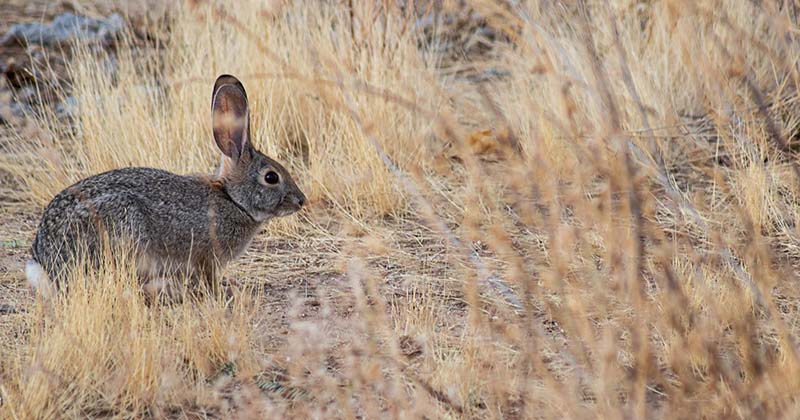If you’ve spent any time in the country, chances are you’ve encountered cottontails. Photographs of kids holding wild baby rabbits (that probably should have been left well enough alone) are part of a Texas country tradition. With their big brown eyes, furry coat, and fluffy tail, rabbits are irresistible, and Texas has a few to enjoy. The Lone Star State is home to three native rabbits and one hare.
Types of wild rabbits and hares in Texas
The eastern cottontail can be found throughout much of eastern and central Texas and is the smallest of the lot, weighing just two to three pounds. The eastern cottontail prefers dense brush which it seldom strays far from. Rabbits are known for their prolific breeding and the cottontail is no exception. In a matter of weeks, cottontails are weaned, fully developed, and ready to leave the nest and the mother is ready to give birth to another litter. As described by Texas Parks and Wildlife Department (TPWD), “in four or five months the young cannot be distinguished from adults.”
The two other rabbits native to Texas are the swamp rabbit, found in the eastern side of the state, and the desert cottontail, found in the western half of the state. The swamp rabbit has a unique characteristic in that it can swim. Per Types of Wild Rabbits in Texas: “Unlike most rabbits, this species not only can swim, it often chooses to do so and with waterproof fur (that) is well adapted to its soggy surroundings.” The desert cottontail is distinctive with slightly longer ears.
Finally, Texas is home to the black-tailed jackrabbit. Despite the moniker, jackrabbits are not rabbits, rather, they are hares. The jackrabbit prefers dry habitats and boasts exceedingly long ears and weighs up to nine pounds. Jackrabbits can reach speeds of 40 miles per hour. The jackrabbit’s taller, powerful hind legs “can propel them on leaps of more than 10 feet…They use these leaps and a zigzag running style to evade their many predators, including coyotes,” notes National Geographic. The jackrabbit’s enormous ears help it lose heat and cool its body temperature. To preserve heat on cold nights, they reduce blood flow through the ears.
Difference between rabbits and hares
Modern Farmer lays out five differences between rabbits and hares which are summarized as follows:
- Baby hares are born looking like miniature versions of their parents, pretty much raring to go and able to live on their own only an hour or so after being born. Baby rabbits are born hairless, blind, and helpless.
- As described above, hares have longer ears and legs.
- Both rabbits and hares molt (shed their coat), but hares tend to have more dramatic seasonal color changes than rabbits.
- Rabbits live in burrow systems called warrens while hares live above ground making their homes in hollow logs or creating simple nests by tromping down grass and vegetation.
About those baby rabbits
As with fawns, the mother rabbit usually stays away from her babies during the day so the urge to “rescue” may not always be the right move. A community in North Texas put together tips about what to do when you encounter a wild baby rabbit, including how to determine if the babies are still being cared for by the mother. Check out What to do When You Find Baby Rabbits and Other Wild Animals.
Rabbit hemorrhagic disease
Even cute fuzzy rabbits are not immune to illness. In 2020, TPWD received test results confirming that rabbit hemorrhagic disease (RHD) was diagnosed in a wild black-tailed jackrabbit in Lubbock County and a wild cottontail rabbit in Hudspeth County. This marked the first confirmed cases of RHD in wild rabbits in Texas. Per TPWD, the highly contagious disease does not affect people or pets (other than pet rabbits). For the latest updates on RHD and its presence in Texas, visit the TPWD Rabbit Hemorrhagic Disease Fact Sheet.
Image by Paul Ramsay from Pixabay









